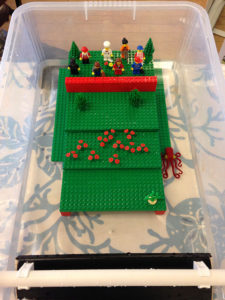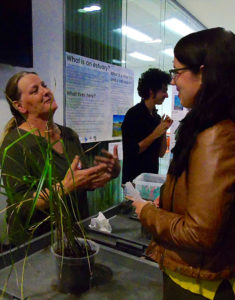The CBESS team at the University of St Andrews joined fellow researchers at ResearchLIVE! in St Andrews.
ResearchLIVE! was part of European Researchers’ Night 2015 where over 300 researchers all over Europe joined forces on Friday 25 September to deliver an evening of discovery, debate and entertainment.
At the CBESS stand we introduced participants to the power of plants and the role they play in coastal defence and reducing erosion.
 A Lego saltmarsh (conceptualised by PhD student Cai Ladd) demonstrated how salt marshes attenuate/absorb the power of waves. Research carried out by Dr Iris Möller at the Cambridge Coastal Research Unit has demonstrated that salt marshes, over a distance of 40 metres, can reduce the height of damaging waves in storm surge conditions by close to 20%.
A Lego saltmarsh (conceptualised by PhD student Cai Ladd) demonstrated how salt marshes attenuate/absorb the power of waves. Research carried out by Dr Iris Möller at the Cambridge Coastal Research Unit has demonstrated that salt marshes, over a distance of 40 metres, can reduce the height of damaging waves in storm surge conditions by close to 20%.
Participants used a paddle to generate increasingly more powerful waves to test saltmarshes as flood defences. They then had the option of adding an engineered hard flood defence to provide additional protection or removing the salt marsh completely (in a development scenario) to see what impacts this could have. Participants concluded that healthy salt marshes were the best option, but that sometimes it was necessary to build a wall for added protection. They also concluded that it was also not the best idea to remove marshes as the exposed engineered hard flood defence became damaged by storm events and was overwhelmed by storm events.
 The roots of saltmarsh plants bind soil together stabalising salt marshes by reducing erosion from wave action. The CBESS team demonstrated this by pouring water through plant pots; some contained salt marsh sedges and grasses while others bare saltmarsh mud. The water that seeped out of the pots with plants in was very clear, compared to water that seeped out of the mud filled pot. This demonstrated how plant roots trap sediment stopping it from eroding.
The roots of saltmarsh plants bind soil together stabalising salt marshes by reducing erosion from wave action. The CBESS team demonstrated this by pouring water through plant pots; some contained salt marsh sedges and grasses while others bare saltmarsh mud. The water that seeped out of the pots with plants in was very clear, compared to water that seeped out of the mud filled pot. This demonstrated how plant roots trap sediment stopping it from eroding.
